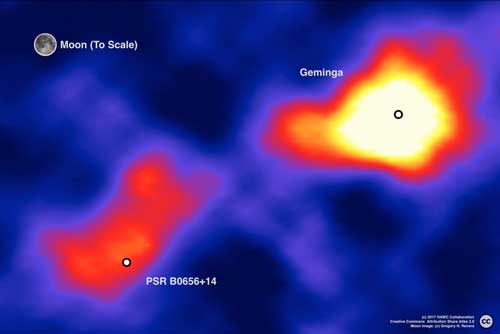| Nov 17, 2017 |
Nearby pulsars shed light on the antimatter puzzle
|
|
(Nanowerk News) There are too many high-energy positrons in the cosmic rays reaching the Earth. These positrons (particles that are antimatter equivalents of electrons) could be being produced by pulsars in our vicinity. The most recent measurements from the HAWC Observatory in Mexico have practically excluded this possibility, strengthening the competing and much more exotic hypothesis concerning the origin of the excess positrons.
|
|
Our planet is immersed in cosmic rays. The particles reaching the Earth from the depths of the Universe include positrons - antimatter equivalents of electrons. Astrophysicists have long been intrigued by why there are far more high-energy positrons in the cosmic rays than could be expected by current theoretical models.
|
|
The latest attempt at an answer is the observations made by a team of several dozen researchers from the United States, Mexico, Germany and Poland, conducted using the recently activated High-Altitude Water Cherenkov Gamma-Ray Observatory (HAWC) detector. The analysis of the measurements of the cosmic ray particles has just been published in the prestigious scientific journal Science ("Extended gamma-ray sources around pulsars constrain the origin of the positron flux at Earth").
|
 |
| In cosmic rays there are more high-energy positrons than could be produced by pulsars in our vicinity: Geminga and PSR B0656+14. (Image: John Pretz)
|
|
"We know that high-energy particles of cosmic rays, travelling through our galaxy, quickly dissipate their energy by interacting with other radiation and magnetic fields. This is how particles of primary cosmic rays behave. Positrons are secondary, they come from interactions in which primary radiation is involved. We would therefore expect a similar dependence: a marked decrease in the number of high-energy positrons," explains Prof. Sabrina Casanova (IFJ PAN) and adds: "The reality is different. Satellite and terrestrial observatories record many more high-energy positrons than they should. Our aim was to check whether the source of the positron excess was astronomical objects in our vicinity, such as pulsars and their surrounding nebulae."
|
|
The HAWC Observatory is located on the slopes of the Mexican volcano Sierra Negra at an altitude of over 4100 metres above sea level. It houses 300 water tanks, surrounded by detectors sensitive to fleeting flashes of light, known as Cherenkov radiation. This radiation appears in the tank when a particle moving at a speed greater than the speed of light in water falls into it. Each day at HAWC, in this manner, the presence of cosmic gamma photons with energies from 100 gigaelectronvolts (GeV) to 100 teraelectronvolts (TeV) is recorded. These are energies even trillions of times greater than the energy of visible light photons and are over a dozen times greater than the energy of protons in the LHC accelerator. (It is worth noting that throughout the history of cosmic ray measurements, particles with energies of even up to 300 000 000 TeV have been recorded.)
|
|
"Detectors at the HAWC observatory record gamma radiation emitted, among others, by a certain population of electrons produced by pulsars and accelerated by them to huge energies. The basic question was: are there enough of these electrons for interactions with them to then produce the right number of positrons?" says Dr. Francisco Salesa Greus (IFJ PAN).
|
|
The experimental team conducted a very detailed analysis of the data collected for two relatively close pulsars known as Geminga and PSR B0656+14. The first is about 800 and the other over 900 light years distant from us. Both are among the strongest sources of cosmic rays in our region of the galaxy.
|
|
The analysis, covering 17 months of observation, showed that the radiation from both pulsars and their surrounding nebulae was indeed responsible for some of the positrons in the cosmic rays. However, contrary to the expectations of a large group of researchers, this contribution turned out to be several times too small to explain the actual number of TeV positrons.
|
|
"Since the involvement of close-by pulsars in the generation of high-energy positrons reaching us is so modest, other explanations become more and more likely. The most interesting is the hypothesis about the origin of excess positrons from the decay or annihilation of dark matter," comments Prof. Casanova.
|
|
If the hypothesis of the origin of positrons from the annihilation or decay of dark matter turns out, over time, to be true, the excess positrons in cosmic rays would be the first particles recorded by humans to be derived from the interaction of dark matter. Whether or not they really are, will be decided by future observations.
|

